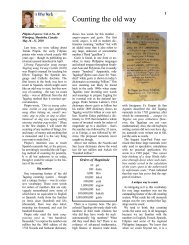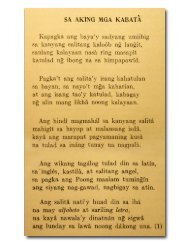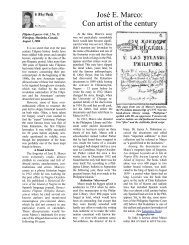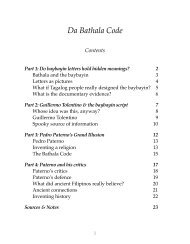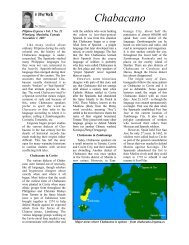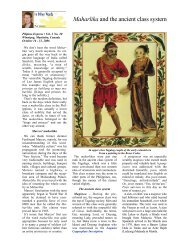Download PDF version - Pilipino Express
Download PDF version - Pilipino Express
Download PDF version - Pilipino Express
Create successful ePaper yourself
Turn your PDF publications into a flip-book with our unique Google optimized e-Paper software.
Clavería’s Catalogue<br />
1<br />
<strong>Pilipino</strong> <strong>Express</strong> • Vol. 2 No. 18<br />
Winnipeg, Manitoba, Canada<br />
September 16, 2006<br />
Filipino surnames can be confusing<br />
for people who are not familiar<br />
with Filipino culture and history.<br />
While there are many indigenous<br />
names in many native languages as<br />
well as Chinese-derived names, the<br />
prevalence of Spanish family names<br />
leads many to believe that Filipinos<br />
are Hispanic – as though they were<br />
Mexicans who just happen to live in<br />
Asia.<br />
Before Spain occupied the Philippines<br />
in the 1500s, most Filipinos<br />
had just one name. Some were descriptive<br />
while others had obscure,<br />
or unknown meanings like most of<br />
our names today. Most of the old<br />
names that appear in history books<br />
belonged to rulers such the datus<br />
Matanda, Lakandula, Lapu-lapu and<br />
Humabon. Some Filipinos had a second<br />
name that described a family<br />
relationship but unlike the old European<br />
custom in which a man was<br />
referred to as “the son of so-and-so”<br />
(Johnson, Peterson etc.), in the Philippines,<br />
people were identified<br />
through their children, as in “the<br />
mother or father of so-and-so.”<br />
Filipino names – anything goes<br />
Governor and Captain General of the<br />
Philippines from 1844 to 1849,<br />
Narciso Clavería y Zaldúa made surnames<br />
mandatory for Filipinos<br />
When Filipinos began to convert<br />
to Christianity, they took on the<br />
names of Catholic saints, symbols,<br />
sacraments, feasts and even popes.<br />
When it came to naming a child or<br />
choosing one’s own Catholic name it<br />
was “anything goes” – not much<br />
different from today except that Hollywood<br />
was not an available source<br />
of names yet. Many Filipinos back<br />
then took two or three names and<br />
changed them whenever they<br />
wanted. Surnames were not strictly<br />
applied to whole families and often<br />
each family member would choose a<br />
Spanish surname that was different<br />
from the rest of the family. The resulting<br />
confusion drove Spanish bureaucrats<br />
crazy because, without<br />
clear family lineages, legitimate<br />
births and inheritances were often<br />
hard to prove and the clergy worried<br />
that Filipinos might be marrying their<br />
own cousins or other family members.<br />
Also, with so many Filipinos<br />
choosing the same popular surnames<br />
like de los Santos and de la Cruz, it<br />
was not easy for the government to<br />
track the movements of Filipinos –<br />
making tax collection and law enforcement<br />
difficult.<br />
A catalogue of surnames<br />
So, after about 300 years of this<br />
confusion, the government decided to<br />
take action. In 1849, Governor Narciso<br />
Clavería began the process of<br />
making a civil register of the entire<br />
population. The first step was to sort<br />
out the names that people already had<br />
and then to make rules so that Filipino<br />
families would all have consistent<br />
surnames.<br />
Clavería released the Catálogo<br />
alfabético de apellidos or the Alphabetical<br />
catalogue of surnames, which<br />
contained 60,662 surnames, both<br />
Spanish and indigenous, that had<br />
been collected by parish priests<br />
throughout the country. The catalogue<br />
was distributed to the head of<br />
each province who was required to<br />
figure out how many surnames each<br />
town would need and then assign<br />
them alphabetically. A list of the allotted<br />
surnames for each town was<br />
given to its parish priest who instructed<br />
the barangay (neighbourhood)<br />
officials to summon the oldest<br />
The book that gave many Filipino<br />
families their names:<br />
the Alphabetical Catalogue of<br />
Surnames, 1849<br />
male member of every family to<br />
choose a family name and have it<br />
entered into the new civil register.<br />
Filipinos who already had surnames<br />
could keep them as long as<br />
they were not on a list of banned<br />
names. To avoid any false claims to<br />
special rights, taking the names of<br />
ancient Filipino nobles like, Tupas,<br />
Lakandula or Rajah Matanda was not<br />
allowed. However, families that already<br />
had a restricted surname could<br />
keep it if they could prove that they<br />
had been using it for at least four<br />
generations.<br />
Overused names like Cruz,<br />
Reyes, Santos and others were supposed<br />
to be banned, too, but Governor<br />
Clavería did allow provincial<br />
officials and priests to use their own<br />
discretion in the matter. Judging by<br />
the huge numbers of these common<br />
surnames that are still around today,<br />
it seems that most officials let it slide.<br />
In some areas, though, such as Quezon<br />
and Albay, the whole law, including<br />
the alphabetical distribution of<br />
names, was so strictly enforced that<br />
in some towns almost everybody’s<br />
surname started with the same letter.<br />
Filipinos who changed their<br />
names after being registered faced at<br />
least eight days in jail or a fine of<br />
three pesos. School teachers were<br />
instructed to keep a register of all
Paul Morrow • In Other Words • The <strong>Pilipino</strong> <strong>Express</strong> • September 16 - 30, 2006<br />
2<br />
their students’ surnames and to make<br />
sure that they matched their parents’<br />
surnames. They also had to make<br />
sure that the students used only their<br />
registered names. If the rules were<br />
not enforced, provincial officials<br />
were allowed to punish the teacher.<br />
Modern myths<br />
Clavería’s decree is at the root of<br />
some myths and misunderstandings<br />
that we have today about Filipino<br />
names. Some people believe that the<br />
Spaniards forced Filipinos to give up<br />
their own names and assume Spanish<br />
names, but this is not true. Clavería’s<br />
catalogue listed all kinds of names<br />
that were collected from all over the<br />
Philippines. The purpose of the catalogue<br />
was not to get rid of native<br />
names but to set up a civil register so<br />
that the government could keep track<br />
of the Filipino population for tax<br />
collecting, law enforcement and<br />
church records. To do that, Clavería<br />
needed Filipino families to have a<br />
surname. The origin of a surname did<br />
not matter as long as each family<br />
member had the same one.<br />
Another myth that some Filipinos<br />
believe is that having a Spanish surname<br />
means having some Spanish<br />
ancestry. They assume, and in some<br />
cases they even claim, that one of<br />
their great-great grandmothers married<br />
a Spaniard, or came to have<br />
children from a Spaniard through<br />
some sordid incident. The truth of the<br />
matter is that for most of the Spanish<br />
era, there were very few Spaniards in<br />
the Philippines. In most provincial<br />
towns, the only Spaniard was the<br />
local friar. According to the 2000<br />
census, 95% of the population in the<br />
Philippines has an unmixed Malay<br />
heritage. Although mestisos (people<br />
of mixed race) are extremely influential<br />
in Filipino society, most estimates<br />
put the combined number of all types<br />
of mestisos at no more than 2% or<br />
3% of the entire population and only<br />
about half of those are Spanish mestisos,<br />
who are based mainly in Manila<br />
and Cebu. Chinese-mestisos and<br />
full Chinese combined are estimated<br />
at only around 3%.<br />
A 2001 Stanford University study<br />
showed a slightly higher percentage<br />
of Filipinos carrying European genetic<br />
material (3.6%), but the sample<br />
size was only 28 people, which<br />
meant that only one of the 28 had any<br />
European ancestry. Also, the samples<br />
were all taken from around Manila<br />
where the mestiso population is concentrated.<br />
The reason that so many Filipinos<br />
have Hispanic last names is mainly<br />
because their ancestors changed their<br />
names when they became Catholics<br />
or when they had to choose a surname<br />
for Governor Clavería’s civil<br />
register in 1849. Taking a new name<br />
when a person became a Christian<br />
was customary, just like it is for people<br />
today who convert to Islam. Often<br />
a priest would choose the name,<br />
but for many Filipinos it was the<br />
“cool” thing to do, anyway. The<br />
Spaniards had the power, so taking a<br />
Spanish surname gave the illusion of<br />
having a little prestige and style. Old<br />
parish records show that some Filipinos<br />
added their new Hispanic names<br />
to their old native names but after a<br />
few years, they would eventually<br />
drop the native part.<br />
Indigenous names survive<br />
Fortunately hundreds of native<br />
Filipino names did survive. Some of<br />
these were high status names that<br />
belonged to important families that<br />
kept them even when they converted,<br />
while other names belonged to those<br />
Filipinos who had eluded Spanish<br />
rule.<br />
Some indigenous names have<br />
obvious meanings while others have<br />
been obscured by time and the evolution<br />
of languages. Many families<br />
have original Filipino names that<br />
may not look Filipino because they<br />
have retained the old Spanish spelling<br />
– names such as Bondoc for bundok<br />
(mountain) or the Ilokano name,<br />
Agcaoili (to hold on to), which<br />
would be spelled Agkawili in modern<br />
Filipino.<br />
Some names are not flattering to<br />
their owners but, for obvious reasons,<br />
most of the native names that have<br />
survived are those that express the<br />
positive or powerful qualities of people.<br />
There is strength and fierceness<br />
in names like, Macaraeg (maka+daig,<br />
able to win), Catacutan (fear), Panganiban<br />
(aware of danger), Agbayani<br />
(Ilokano, to be heroic) and Mangubat<br />
(Cebuano, to fight). There is defiance<br />
in Tagalog names like: Dimaapi<br />
(“cannot be oppressed”), Dimayuga<br />
(unshakeable). A favourite of mine is<br />
Lacanilao (Lakan+ilaw) or “noble<br />
light.”<br />
Native Filipino first names<br />
gained a measure of popularity in the<br />
20th century with some nationalistic<br />
parents giving their children Tagalog<br />
names such as Bayani (Hero), Magtanggol<br />
(Protector), Makisig (Handsome)<br />
and Diwa (Spirit) for boys, or<br />
Ligaya (Joy), Malaya (Free), Luwalhati<br />
(Glory), Mayumi (Modest) and<br />
Luningning (Brilliance) for girls.<br />
Chinese names<br />
There are many Filipino surnames<br />
that look Hispanic but are<br />
really Chinese. Today most Chinese<br />
surnames have only one syllable, but<br />
until the 1800s, Chinese-Filipino<br />
families usually had three syllables in<br />
their names because they used the<br />
complete name of their patriarch.<br />
Other families may have come from<br />
northern China where two-syllable<br />
names are not uncommon. These<br />
names became more Spanish sounding<br />
when they were written in the<br />
Spanish alphabet.<br />
One of the most famous of these<br />
is former president Corazon Aquino’s<br />
maiden name, Cojuangco. The head<br />
of the Cojuanco family at one time<br />
was Ko Chi Kuan, who was respectfully<br />
addressed by adding Ko to the<br />
end of his name and dropping his<br />
given name, Chi. Thus, Ko Chi Kuan<br />
was known as, Ko Kuan Ko, which<br />
eventually became Cojuanco in the<br />
Spanish spelling.<br />
Some other hispanized Chinese<br />
names are Locsin (Xin Luk), Joson<br />
(Ho Sun), Lantin, Dizon, Quison,<br />
Vinzon, Licuanan, Landicho, Guingcanco,<br />
Lauchengco and Quisumbing.<br />
These names were once Chinese, but<br />
today they are uniquely Filipino and<br />
not found in China.<br />
Whatever the origin – Hispanic,<br />
Chinese or native – most Filipinos<br />
today possess family names that only<br />
date back to 1849; and for that, they<br />
can thank (or blame) Clavería’s catalogue.<br />
E-mail the author at:<br />
feedback@pilipino-express.com or<br />
visit www.mts.net/~pmorrow for<br />
more about Filipino history and<br />
language. Comments are also<br />
welcome on Paul Morrow’s<br />
FaceBook page.
Paul Morrow • In Other Words • The <strong>Pilipino</strong> <strong>Express</strong> • September 16 - 30, 2006 3<br />
Sources:<br />
Abella, Domingo & Norman Owen, Catálogo Alfabético de Apellidos (1849), National Archives Publication No.<br />
D-3 (1973)<br />
All Experts.com. Demographics of the Philippines, www.associatepublisher.com/e/d/de/demographics_of_the_<br />
philippines.htm. Retrieved September 5, 2006<br />
Capelli, Christian et al. “A Predominantly Indigenous Paternal Heritage for the Austronesian- Speaking Peoples of<br />
Insular Southeast Asia and Oceania.” American Journal of Human Genetics 68:432–443, 2001.<br />
Philippines Genealogy Web Project. Surnames FAQ. Created on: October 11, 1997. Last updated: October 28,<br />
2001. http://reocities.com/Heartland/ranch/9121/surnamesfaq.html. Retrieved August 29, 2006<br />
Santos, Hector. Katálogo ng mga Apelyidong <strong>Pilipino</strong> (Catalog of Filipino Names) at www.bibingka.com/names.<br />
US, May 3, 1998. Retrieved August 28, 2006.



